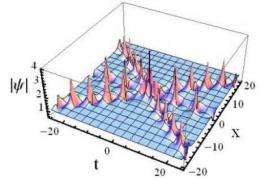Making monster waves

Rogue waves -- giant waves that spring up suddenly and tower over the seas around them—have inspired physicists to look for an analogue in light. These high-intensity pulses can cross large distances without losing information. Now a team of physicists have identified one set of conditions that produces optical rogue waves. Their findings are reported in Physical Review A and highlighted with in the October 19 issue of Physics.
Rogue waves were thought to be a sailor's tall tale until an 85-foot wave broke over an oil platform in the North Sea in 1995. Since then, scientists have tried to understand how such outsized waves arise from the erratic interactions of smaller waves on a choppy sea, with an eye toward creating them on purpose in the form of light traveling in an optical fiber.
While versions of quantum mechanical equations describe how optical rogue waves evolve, it's still difficult to pinpoint the conditions necessary to get them started. Now Nail Akhmediev of the Australian National University and his team have identified one possibility using theory—breathers, or small peaks that appear suddenly in one spot and disappear almost immediately, could seed rogue waves.
Akhmediev's team found that two or three breathers, if they collide in exactly the right place at the right time, form an optical rogue wave. The researchers say the effect could be seen in water waves in a long, narrow tank. Their findings increase scientists' understanding of how to cook up optical rogue waves for communications applications.
More information: How to excite a rogue wave, N. Akhmediev, J. M. Soto-Crespo, and A. Ankiewicz, Phys. Rev. A 80, 043818 (2009) - Published October 19, 2009, Download PDF (free)
Source: American Physical Society











.jpg)





